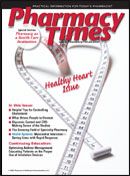Publication
Article
Pharmacy Times
Fiber Supplements
Author(s):
When assisting patients in the selection of fiber supplements, pharmacists should remind patients to increase fiber intake gradually over time.
Ms. Terrie is a clinical pharmacy writer based in Haymarket, Virginia.

According to the recommendations ofthe American Dietetic Association, ideally,healthy adults should have a dailyintake of 25 to 30 g of dietary fiber, whilechildren older than 2 years of age shouldconsume a daily intake of dietary fiberequal to their age plus 5 g.1 The Instituteof Medicine also recommends that individualsshould consume at least 14 g offiber for every 1000 calories.2 In general,however, the average daily intake offiber for most individuals in the UnitedStates is only 14 to 15 g.1,2
Sources of dietary fiber include fruits,vegetables, whole grains, legumes, andbeans. The American Heart Association(AHA) recommends that at least halfof daily grain intake come from wholegrain foods.2 Dietary fiber can be dividedinto 2 basic categories: soluble andinsoluble.
- Soluble fiber slows digestion andassists the body in absorbing vitalnutrients from foods.3,4 It dissolvesin the water found in the large intestineand forms a gel.3,4 This formof fiber can aid in lowering totalcholesterol levels and low-densitylipoprotein cholesterol levels, aswell as improve glycemic index inpatients with diabetes.1-3 Foods highin soluble fiber include oat bran,barley, peas, rice bran, beans, applepulp, citrus fruits, strawberries, andpsyllium husk.2,4
- Insoluble fiber does not dissolve inwater, but it increases the movementof waste through the intestinaltract.3,4 Insoluble fibers havebeen associated with decreasedcardiovascular risks and slow progressionof cardiovascular disease,particularly in high-risk individuals.1,2 In addition to preventing constipation,this type of fiber may alsoaid in removing toxic waste in thecolon. Foods high in insoluble fiberinclude wheat bran, whole grains,rice, flax seed, nuts, popcorn,cabbage, beets, carrots, Brusselssprouts, turnips, cauliflower, andapple skin, as well as other fruitsand vegetables with skins.2,4
Adequate intake of dietary fiber is themost recommended choice for both theprevention and treatment of constipationand also has an important rolein the maintenance of normal bowelfunction. In addition, various studieshave demonstrated that an increasedintake of fiber can promote varioushealth benefits and possibly preventor reduce various chronic health problems.1 Examples include lowering therisk of developing hemorrhoids or diverticulosis,aiding in the management ofirritable bowel syndrome, promotingbetter management of glucose levelsin patients with diabetes, promotingweight loss, and restoring regularity forindividuals on low-carbohydrate diets.1-3In addition, adequate fiber intake mayaid in lowering cholesterol levels andblood pressure, as well as decreasingthe risk of colon cancer.1-3
Many patients still find it difficultto consume the American DieteticAssociation's recommended intake ofdietary fiber; thus, some individualselect to use the various fiber productson the market to supplement theirdietary fiber intake and to maintainnormal bowel function to prevent orreduce episodes of constipation. Fiberproducts on the market may containvarious fiber sources that include wheatdextrin, methylcellulose, psyllium husk,inulin, and calcium polycarbophil.Pharmacists can provide essential guidanceto patients regarding the properselection of fiber supplements and canensure that patients use these productscorrectly according to the manufacturers'recommendations. Currently, fibersupplements are available in a varietyof dosage formulations, such as shakes,chewable tablets, wafers, and powdersin several different flavors (Table). Manypowder formulations can be mixed with4 to 8 ounces of water or noncarbonatedbeverage or in soft foods such as applesauce. Some fiber supplements containcalcium and vitami ns/minerals. Patientsshould be advised to read labels of fibersupplements to avoid the possibility oftherapeutic duplications.
Role of the Pharmacist
When assisting patients in the selectionof fiber supplements, pharmacistsshould remind patients to graduallyincrease fiber intake over time to avoidor reduce the incidence of adverseeffects, such as intestinal flatulence,bloating, diarrhea, and cramping. Theincrease should be gradual over a fewweeks, and, if possible, patients shouldalso increase water intake. Inadequatefluid intake may decrease efficacy ofthe product and may cause intestinalor esophageal obstruction.5 Many manufacturersof fiber supplements havereminders on the product label that typicallyrecommend taking fiber supplementswith 8 ounces of water to avoidchoking.6-8 Patients with preexistingmedical conditions, such as those whomust restrict fluid intake (eg, patientswith renal dysfunction, congestive heartfailure)3 and those currently taking anymedications should discuss the use ofthese supplements with their primaryhealth care provider prior to using theseproducts.
Furthermore, because fiber supplementscan decrease the absorptionof many medications, patients shouldalways be advised to take supplements2 to 3 hours before or after other medicationsand to report any concerns totheir physician. Patients should also bereminded that the use of fiber supplementsshould never be a substitute for afiber-rich diet that contains other essentialvitamins and minerals necessary forhealth. It is important to remind patientsto try to obtain most of their daily intakeof fiber through dietary means.
Table 1
Examples of Available Fiber Supplements
Brand Name (Active Ingredient)
Manufacturer
Benefiber Products (wheat dextrin)
Novartis Consumer Health Inc
Benefiber Ultra Caplets
Benefiber Chewable Tablets
Benefiber Powder
Benefiber Plus Calcium (300 mg calcium)
Citrucel Products (methylcellulose)
GlaxoSmithKline
Citrucel Powder
Citrucel Soft Chews
Citrucel Caplets
Citrucel FiberShake
Citrucel FiberSmoothie
FiberChoice (inulin)
GlaxoSmithKline
FiberChoice Chewable Tablets
FiberChoice Weight Management Tablets (also contains chromium picolinate and green tea)
FiberChoice Plus Calcium (contains 500 mg calcium and 200 IU of Vitamin D)
FiberChoice Plus Multivitamins (contains 13 essential vitamins and minerals)
Fibercon Caplets (calcium polycarbophil)
Wyeth Consumer Healthcare
Fibersure Powder (inulin)
Procter & Gamble
Konsyl Products (psyllium hydrophilic mucilloid)
Konsyl Pharmaceuticals Inc
Konsyl-D
Konsyl Easy Mix
Konsyl Fiber Caplets (calcium polycarbophil; for individuals allergic to psyllium fiber)
Konsyl Orange
Konsyl Original
Konsyl Psyllium Capsules
Konsyl SennaPrompt
Metamucil (psyllium husk)
Procter & Gamble
Metamucil Original
Metamucil Fiber Powdered Drink Mixes
Metamucil Fiber Wafers
Metamucil Heart and Digestive Health Capsules
Metamucil Strong Bones (contains 300 mg calcium carbonate)
UniFiber (powdered cellulose)
Alaven Pharmaceuticals LLC
References
- Marlett JA, McBurney MI, Slavin JL. Position of the American Dietetic Association: health implications of dietary fiber. J Am Diet Assoc. 2002;102(7):993-1000. www.adajournal.org/article/S0002-8223(02)90228-2/fulltext.
- Fiber. American Heart Association Web site. www.americanheart.org/presenter.jhtml?identifier=4574. Accessed September 30, 2008.
- Rollins CJ. Functional and Meal Replacement Foods. In Berardi RR, ed. Handbook of Nonprescription Drugs. 15th ed. Washington, DC: American Pharmacists Association; 2006:484-485.
- Soluble vs. Insoluble Fiber. MedlinePlus Web site. www.nlm.nih.gov/medlineplus/ency/article/002136.htm. Accessed September 30, 2008.
- Curry CE, Butler DM. Constipation. In Berardi RR, ed. Handbook of Nonprescription Drugs. 15th ed. Washington, DC: American Pharmacists Association; 2006:305-309.
- Metamucil Product Information. Metamucil Web site. www.metamucil.com. Accessed September 30, 2008.
- Fibercon Product Information. Fibercon Web site. www.fibercon.com. Accessed September 30, 2008.
- The Fiber Chronicles: Answers to Your Questions. Citrucel Product Information. www.citrucel.com/Ch5_FAQ.aspx#crush. Accessed September 30, 2008.







